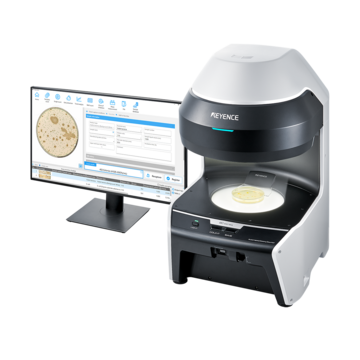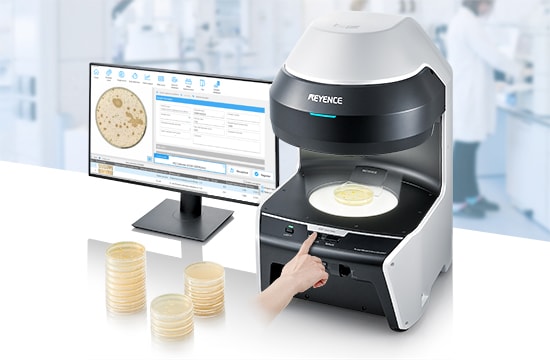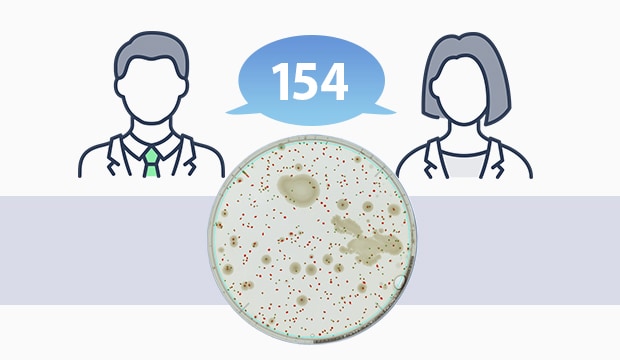Colony Counter

KEYENCE’s automated colony counter uses a built-in camera to capture images of samples and then uses image-processing technology to automatically count the number of colonies. This allows for shorter count times, even with a large number of colonies. Moreover, while results may be inconsistent depending on the skill of the person counting the colonies visually, this automated colony counter enables reliable, stable counting by matching image capturing conditions and image processing settings for more efficient microbiological testing.
Product Lineup

Automatically count colonies in just 1 second for accurate automation of microbiological testing. By integrating proprietary optics, lighting, and image-processing technologies, it becomes possible to accurately count even the tiniest colonies using a cutting-edge 20-megapixel CMOS sensor with high definition. Optimal lighting ensures that every colony is clearly visible for accurate counting while also excluding accidental counting of residue. Counting results are also converted directly into data, eliminating the need for manual transcription and ensuring reliable digital management.
Features
Results in Just 1 Second with “Place-and-Press” Counting
Simply place the Petri dish on the stage and press the button to get accurate colony counts. The system has preset optimal inspection settings for specific culture mediums and other factors, allowing even novice users to get accurate counts.
Conventional methods

BC-1000

Reliable, Repeatable Results for All Users
Stable detection is possible with 99% accuracy even for microcolonies. Accurate counting is even possible for samples that cannot be easily counted with conventional methods.

Colony counters are used to count the number of bacteria colonies (clusters) and other microorganisms. They are generally classified as either manual or automatic counters.
Manual colony counters are used to assist with visual counting of colonies. They generally include transmitted lighting for illuminating a Petri dish with cultured microorganisms and a loupe for easier identification of smaller colonies. Some types even include a built-in counter that can be pressed with an attached pen.
Automated colony counters, however, use a built-in camera to capture images of samples and then use image-processing technology to automatically count the number of colonies. This allows for shorter count times, even with a large number of colonies. Moreover, automated colony counters enable reliable, stable counting by matching image capturing conditions and image processing settings for more efficient microbiological testing.
Benefits of Automated Colony Counters
Automated colony counters make it possible to count colonies in much less time than with manual counting.
The time required for counting will very depending on the number of colonies.
With manual counting, the accuracy of the results will depend largely on the skill of the person doing the counting, and results may vary between inspectors even for the same sample. Moreover, continuous counting of small colonies requires significant physical and mental effort, which could lead to oversights depending on the physical condition and fatigue level of the person doing the counting.
However, automated colony counters ensure counts can be made under the same conditions, enabling stable counting with no variations.
Count results obtained with an automated colony counter are directly converted into digital data. This data can then be exported to a spreadsheet or other software for keeping records but also for a variety of analyses including product- and location-based trend surveys.
The digitization of a series of operations also makes it easy to systemize measures to prevent data tampering and to record operation logs (audit trails), allowing for easy compliance with 21 CFR Part 11 and other regulations.
Frequently Asked Questions About Automated Colony Counters
KEYENCE’s BC-1000 Series Automated Colony Counter can be used with sheet culture media and well plates, in addition to Petri dishes. The system offers holders for each type of container.
The BC-1000 Series includes various features such as user management and audit trails that allow for compliance with 21 CFR Part 11.
Compliance with counting methods of various other standards—including FDA BAM, AOAC 977.27, GB 4789.2, GB 7918.2, ISO 7218, ISO 4833.2, and ISO 15189—is also possible.
Data integrity (DI) refers to data that is complete, consistent, and accurate. In other words, data integrity refers to the reliability of the data.
This is a basic requirement of Good Manufacturing Practices (GMP; Pharmaceutical Manufacturing Control & Quality Control Standards), a pharmaceutical industry concept that manufacturers are required to comply with.
Data integrity is a requirement for all types of recording media, and appropriate measures must be taken regardless of the recording method (paper, digital, etc.).
Counting colonies with an automated colony counter takes two steps: Capturing an image, and then processing the image. Various requirements must be met to achieve the best results in each step.
Points on Image Capturing
When considering what it takes to capture good images, the first thing that comes to mind is probably the number of pixels of the camera. While the number of pixels is one of the most important factors, the following points must also be taken into consideration to ensure captured images are suitable for automatic colony counting.
Does the lens have a high enough resolution to ensure there is no distortion across the entire Petri dish?
If the curvature of the image or distortion and aberrations are not sufficiently corrected, the image may appear shifted or distorted along the edges of the field of view, and this can affect counting. Moreover, the resolution of the image will depend on the resolution of the camera or lens; even with a high-pixel camera, a lens with low-resolution optics will result in insufficient resolution for imaging.
Does the lighting evenly illuminate the entire Petri dish?
Uneven lighting can result in visibility differences of the colonies at different positions, which can adversely affect the counting results. Changing how the Petri dish is placed can also change the appearance of the sample, leading to problems such as different results even when counting the same sample.
Can the lighting be used for a variety of bacteria and media?
For some bacteria species and culture mediums, illuminating the Petri dish from the front (epi-illumination) may be best, while for others illuminating the sample from the back (transmitted illumination) may be best. In addition, some samples may need to be illuminated using diffused and softened light rather than direct illumination. A device with a flexible lighting system that offers various conditions makes it easier to obtain the best image for automatic counting.
Is setting the image capturing conditions easy for anyone?
When it comes to microbiological testing, counting will likely be performed for a variety of samples in sequence based on a production plan. Having to take time to adjust the lighting conditions for each inspection will significantly reduce the effectiveness of automatic counting. Ensuring that the settings can be easily configured and that the conditions can be reproduced when needed will help improve the efficiency of operations.
Points on Image Processing (Count Condition Settings)
Colonies come in many different shapes and sizes, and when counting visually, the experience and the skill of the counter will affect the results. With automatic counting, however, the various shapes are broken down into parameters according to color information (hue, saturation, brightness, etc.) and shape information (area, circularity, etc.), and thresholds are set for each parameter to determine the count targets. Setting all of these parameters individually is complicated and time-consuming, so from an operational perspective, having a simplified interface that allows users to automatically configure as many settings as possible is best.

